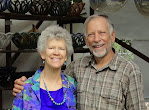April 22-24
Monday, April 22, in Puno we spent much of the day buying parts for an improved wood cook stove for Eufrasia. We've had this dream for over a decade as we observed smokey kitchens and worried about lung damage of the cooks and the children.
Felipe Huatta Cruz had taken a workshop in
estufas mejoradas in Lima, and we contracted him to come help install such a stove in Eufrasia's kitchen. The old kitchen had NO CHIMNEY, only an opening in the ceiling, and was horribly smokey. Even the bedrooms on the upper floor became intolerable when someone was cooking with wood early in the morning.
The essential elements that make the stove clean burning are 1) a chimney, 2) a damper and 3) a primary air source UNDER the fire.
The base for the stove is a terra cotta shell, or
concha, with three burner holes and a flue hole at the back. Ruperta helped choose one in the market in Puno.
 |
| Buying the terra-cotta concha in the market |
Adobe blocks and rock make the structure.
 |
| Concha in place on the adobe layout, showing the ash pit |
Under the firebox is an ash pit and primary air source. We bought a metal plate and had holes drilled in it for the ashes and air. We pounded a stake to enlarge the holes in the center for ash to fall through.
 |
| heavy duty metal plate for the floor of the firebox |
 |
| mudding everything in place |
A bent piece of rebar held up the firebox floor with the holes.
 |
| We bought the metal plate too small, so Felipe bent a length of rebar to hold it in place. |
The terra cotta was completely surrounded by clay and smoothed on the top so the pots fit tight.
 |
| Hole knocked through the stone and adobe wall for the flue opening |
 |
| Showing the damper plate |
Artistic sensibilities entered the picture with careful finishing of the mud surface.
 |
| smoothing the clay |
 |
| filling in with clay mud |
We bought sheet metal, which Silvano and Sam cut the long way and rolled into chimney pipes.
 |
| Silvano fabricates the stove pipe from sheet metal |
Sunny courtyard for making the stove pipe; Lake Titicaca in the background.
 |
| Cap on the top of the stovepipe to keep out the rain |
The chimney needed to be tall enough to clear the second story.
 |
| Lifting the stove pipe into place |
A small "mouse hole" was left at the base of the chimney outside to assist the draw of the smoke.
 |
| Wiring the base of the chimney to stakes in the adobe wall |
As soon as the job was done, we tested the freshly made stove with its first fire.
NO SMOKE IN THE KITCHEN!
 |
| Eufrasia is a Happy Cook |
Note the shiny pots; Eufrasia scrubbed all the soot off because the new stove design will keep them soot-free.
 |
| Silvano feeds the fire for supper. |
Delfin improved the steps between the kitchen and the dining room the next day.
We cooked on it while the clay was still wet and ¡the kitchen was 99% Smoke Free! ¡Hooray! Even better for breakfast the next morning. No smoke in the bedrooms.
Now Ruperta wants one right away. She grew up in a smokey kitchen and already has some lung issues.

















































